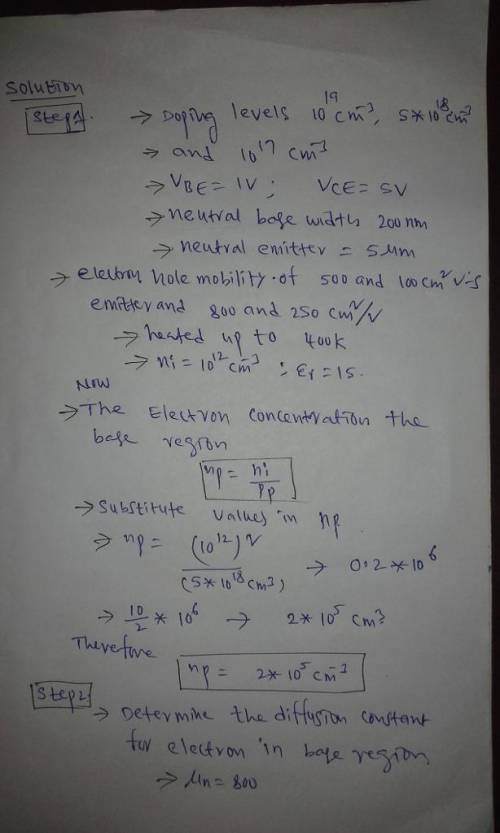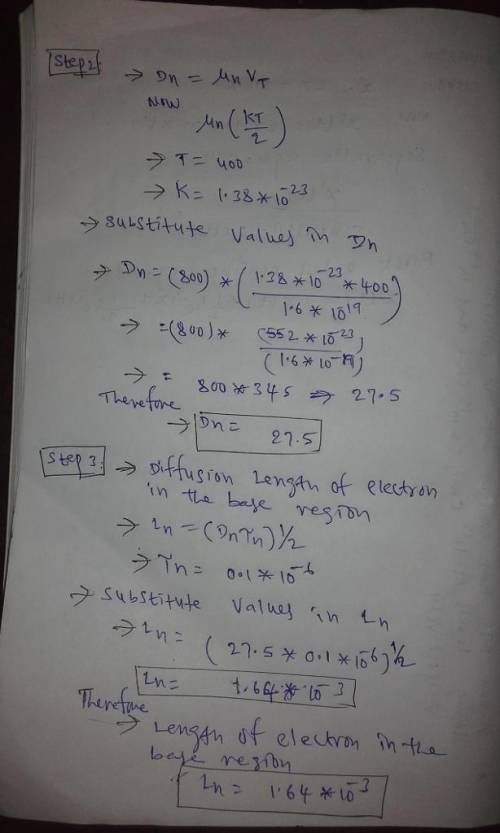
Engineering, 28.05.2020 01:07 ineedhelp2285
An npn BJT has emitter, base, and collector doping levels of 1019 cm3, 5 1018 cm3, and 1017 cm3, respectively. It is biased in the normal active mode, with an emitter-base voltage of 1V. If the neutral base width is 100 nm, the emitter is 200 nm wide, and we have negligible base recombination, calculate the emitter current, emitter injection efficiency, and base transport factor

Answers: 2


Other questions on the subject: Engineering

Engineering, 03.07.2019 14:10, volleyballfun24
If the thermal strain developed in polyimide film during deposition is given as 0.0044. assume room temperature is kept at 17.3 c, and thermal coefficient of expansion for the film and the substrate are 54 x 10^-6c^-1 and 3.3 x 10^-6c^-1respectively. calculate the deposition temperature.
Answers: 3


Engineering, 04.07.2019 18:20, maciemarklin79981
A3-mm-thick panel of aluminum alloy (k 177 w/m-k, c 875 j/kg-k and ? = 2770 kg/m) is finished on both sides with an epoxy coating that must be cured at or above t,-150°c for at least 5 min. the production line for the curing operation involves two steps: (1) heating in a large oven with air at ts,0-175°c and a convection coefficient of h, 40 w/m2. k, and (2) cooling in a large chamber with air at 25°c and a con- vection coefficient of he 10 w/m2.k. the heating portion of the process is conducted over a time interval te which exceeds the ime required to reach 150°c by 5 min (h = r + 300 s). the coating has an emissivity of ? = 0.8, and the temperatures of the oven and chamber walls are 175 and 25°c, respectively. if the panel is placed in the oven at an initial temperature of 25°c and removed from the chamber at a safe-to-touch tempera ture of 37°c, what is the total elapsed time for the two-step curing operation?
Answers: 3

Engineering, 04.07.2019 19:20, Katmcfee7681
Acommercial grade cubical freezer, 4 m on a side, has a composite wall consisting of an exterior sheet of 5.0-mm thick plain carbon steel (kst= 60.5 w/m k), an intermediate layer of 100-mm thick polyurethane insulation (kins 0.02 w/m k), and an inner sheet of 5.0- mm thick aluminium alloy (kal polyurethane insulation and both metallic sheets are each characterized by a thermal contact resistance of r 2.5 x 104 m2 k/w. (a) what is the steady-state cooling load that must be maintained by the refrigerator under conditions for which the outer and inner surface temperatures are 25°c and -5°c, respectively? (b) for power saving purpose, which wall material should be increased/reduced in. thickness in order to reduce 50% of the cooling load found in part (a)? redesign the thickness of the proposed material. 177 w/m-k). adhesive interfaces between the q=575.93 w
Answers: 2
You know the right answer?
An npn BJT has emitter, base, and collector doping levels of 1019 cm3, 5 1018 cm3, and 1017 cm3, res...
Questions in other subjects:


History, 07.10.2019 16:30

History, 07.10.2019 16:30


Health, 07.10.2019 16:30

Mathematics, 07.10.2019 16:30



Mathematics, 07.10.2019 16:30

Mathematics, 07.10.2019 16:30





